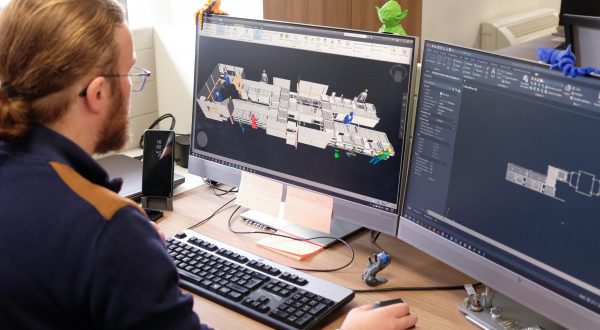Cegelec and Actemium have developed a safety-training programme using virtual reality. The efficient and effective system has been adapted and applied in a variety of business units within the VINCI Energies Group, and will soon be adapted among their customers.![]()
An electrician climbs into a lift platform to change a bulb at the top of a streetlight. The platform rises and stops near the top of the pole, the technician reaches out to remove the defective bulb and receives an electric shock. Disoriented, he tumbles from the platform … and removes the virtual reality (VR) helmet that has just put him through this edifying experience.
The experience is part of a safety-training programme developed at VINCI Energies. The employee is then debriefed: he had remembered to use his PPE (personal protection equipment) – helmet, harness and gloves – but forgotten to lock out the electrical cabinet before entering the platform.
Sébastien Bouteille, describing the scene, is happy with the effect it produced. “The fall trainees suffer when they make that mistake is spectacular, and trainees will not soon forget it,” says the civil engineering worksite manager at Cegelec Tours Infras (VINCI Energies).
The omission on the part of the Cegelec employee is one of the errors that can suddenly turn a job into a calamity. Rinus van den Driest, Actemium Netherlands Business Unit Manager, and Dirk Schyvinck, his counterpart at Actemium Belgium, explain that their business units developed the VR training system based themselves on the ten most frequent mistakes made by their employees.
Better than a slideshow
“The total immersion provided by the virtual reality helmet has a far greater impact than conventional slide shows,” says Sébastien Bouteille, who appreciates the programme developed by his Belgian and Dutch colleagues. He adds that “VR puts the trainee in a technical environment – such as a power plant – that is not often available for training, and where you cannot risk making mistakes.”
Safety training will be expanded beyond initial awareness raising to cover specific case studies.
A final argument in favour of virtual reality is its economy of resources. To train employees under actual conditions, it is sometimes necessary to travel to a remote site. The helmet brings the employee to the training site virtually, saving the business unit time and travel costs.
Case studies
Thanks to virtual reality, safety training at VINCI Energies will be expanded beyond initial awareness raising to cover specific case studies.
At Cegelec Tours Infras, Sébastien Bouteille is already developing further modules for his teams. One focus, for example, is on earthworks. A machine is excavating on the worksite, but the foreman has failed to carefully scrutinise the DICT (declaration of intent to begin works) documents, obtain information on existing utility lines and carry out the appropriate markings on the ground. The excavator rips out a cable. Here again the consequences for the technician are spectacular and harmful.
Actemium Netherlands and Actemium Belgium are taking the same approach and “developing new safety training programmes,” says Actemium Belgium Business Unit Manager Dirk Schyvinck. The programmes focus on accident prevention when installing high-voltage power lines, preventing fire in underground connections and avoiding risks relating to traffic, work at height, installation cleaning and similar situations.
Actemium and Cegelec business unit customers will be the next beneficiaries of these innovations.
Learn more:
https://www.realite-virtuelle.com/


